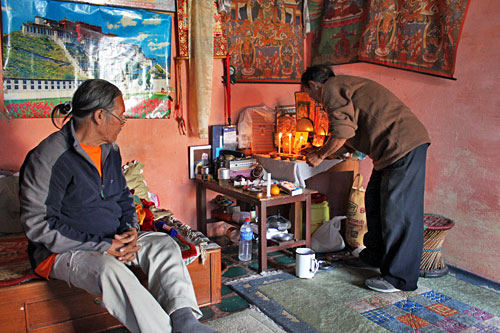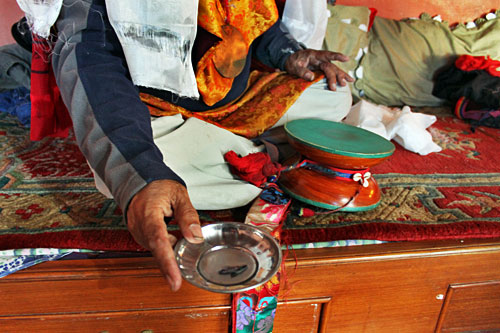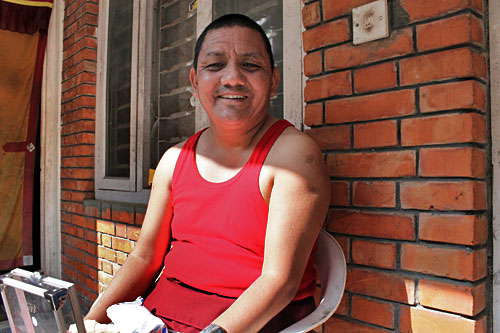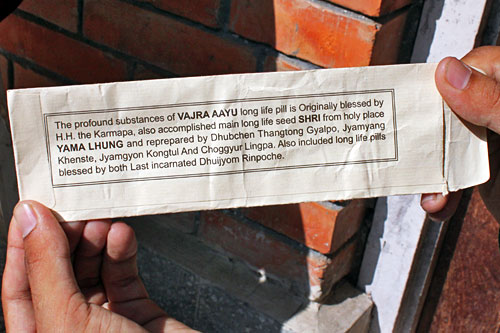Chime led me down a narrow grass pathway at Tashi Palkhiel, the Tibetan refugee settlement on the outskirts of Pokhara, Nepal where he’d grown up. Midway down the lane he stopped before a diminutive man with a long gray ponytail and gleaming onyx eyes. The elder Tibetan grasped my translator’s hands between his own as they bowed and touched foreheads in a respectful greeting. Pau Nyima Dhondup, the village shaman, or Lhapa, flashed a broad smile and considered me for a long moment, his eyes broadcasting delight and laughter, along with a healthy dose of mischief. Shepherding us to his modest home, the shaman swept aside a floor-length cloth covering the front door and gestured for me to sit on a daybed pushed up against the near wall of his front room.

Pau Nyima, who practices a shamanic tradition passed down through his maternal bloodline, is one of only two known living Tibetan shamans remaining in the world today, according to the Foundation for Shamanic Studies in Mill Valley, California. He was chosen to continue his family’s healing tradition when he entered puberty and started having spiritual experiences that indicated his fate was to be a Lhapa. In addition to sucking illnesses out of a body, with actual objects being spit out to show the patient the source of their illness, shamanic treatments can also include a soul retrieval ceremony, a ceremony to release a deceased soul who is stuck into the afterlife, or a ritual to end misfortune that causes child after child in a family to die. The shaman drew up a chair in front of me and gave instructions to Chime.
“He wants you to support right elbow in palm of left hand and bend arm up in air.”
He felt the pulse at my wrist and motioned for me to switch arms in order to repeat the process on the other arm. Scooting back his chair to the middle of the room, he listened attentively as Chime described the pain in my left hip and knee and chortled when he demonstrated how I have to open my mouth wide to relieve the muscular tightness in my jaw, then asked questions.
“How old you are?” Chime inquired.
“Fifty-eight.”
“Ahhh!” the shaman exclaimed, as if learning my age had given him a major clue to my health.
“What country?”
“USA. But I don’t live there any more.”
Chime explained that I am a perpetual traveler with no permanent home, that I move from place to place around the world in search of travel stories. Satisfied that he had all the necessary information, Pau Nyima sat cross-legged on a second daybed on the other side of the small room. While donning a gold silk brocade apron and cape, he warned that we could take photos during part of the ceremony, but strongly recommended that we not use the camera once his body was taken over by the spirit because the deity often breaks things. He finished off his attire with an ornate green, blue and red headdress while his mediator, who runs the ceremony once the shaman is possessed, set up rice offerings, lit candles, and positioned photos of the shaman’s various deities on the altar.
“You must believe,” he warned gravely before beginning. His right hand held an hourglass-shaped, double-sided hand drum that represented two inverted skulls and symbolized the joining of female and male energies. Two clappers attached to strings hanging from the drum’s handle flew through the air as he rotated his wrist back and forth, striking the animal-hide drum in a four-beat rhythm, interspersed with chiming from a bell held in his left hand.
“You have two white stars in the east, a yellow one in the south, blue in the north and red in the west. You must pray only to Buddha – no other gods,” Chime translated for me. The shaman stopped briefly to add a second headdress that spread out behind him like rainbow angel wings and draped it with multi-colored silk scarves. Seconds later, while chanting intensely, a shudder passed through his body and a grimacing, contorted visage appeared superimposed on his face. He uttered a sharp yelp and threw a handful of silk scarves at me. Jumping off the daybed, he spread his arms wide and balanced on one foot, holding the other foot high in the air as if preparing to throw a karate kick. Nyenchen Thanglha, one of the strongest Tibetan deities, had taken control of his body.
Following a brief dance around the center of the room, Pau Nyima resumed his seat and motioned for me to sit directly in front of him on a low wicker stool. Almost immediately, he sprang forward from his sitting position and chomped the air above my upper left arm. The mediator poured a small amount of water into a tin dish and held it as the shaman spit out an inch-long slug that looked like a dark gray caterpillar; it squirmed around in the water, turned black and eventually stopped moving. Unexpectedly, the shaman lunged at me again, this time grazing my left left arm just above the elbow, and spit out a second, blacker slug. As I returned to my seat on the daybed, my arm turned ice cold and tingly.

The deity departed as suddenly as it had arrived. Unaware of what had happened during the time his body was possessed, the shaman turned to his mediator for a briefing. Nyima held out the two unmoving slugs for photos, then raised the plate to his mouth and swallowed them with a gulp and shudder before delivering my diagnosis and instructions for recovery:
- I must believe
- I must pray only to Buddha
- I must not eat meat
- I am coming into my 59th year, which is not auspicious for a woman, thus I must have a lama chant a puja on my behalf
- I must take the Tibetan natural medicine Ratna Samphal (also known as Sambe) – once now and one in six months
- I must not go into cemeteries as I am susceptible to picking up negative energies, such as the ones he removed from my body
- I must regularly chant Om Mani Padme Hum
- I should not travel so much; it would be better to stay in one place much of the time and it would be positive for me to settle in Nepal
In the weeks that followed, I had little trouble following the shaman’s prescription. I am a Buddhist, I’m a vegetarian, I regularly chant Om Mani Padme Hum when I meditate, and staying longer in Nepal is hardly a hardship. But just to be safe, I asked Chime to arrange for a lama at the community’s Jangchub Choeling Monastery to chant a puja and later hunted down the recommended natural medicine.


So do I believe? I know what I saw and my arm was ice cold the rest of the day, so yes, I definitely believe. And I am not alone. Recently, the Foundation for Shamanic Studies named Pau Nyima a “Living Treasure of Shamanism” and provided him with a lifetime annual stipend, assuring that he will be able to pass on shamanic knowledge that is rapidly disappearing from the face of the earth.
If you plan to visit Pokhara and would like to experience a shamanic healing with Pau Nyima Dhondup, take a taxi to Tashi Palkhiel Tibetan Refugee settlement. Since the young man who arranged my visit has now emigrated to Canada, the only way I know to find Shaman Pau Nyima is to show up at the camp and ask around for him. I have done this several times; he is often in the center of the camp socializing with other men. A taxi should cost you between 500-700 Rupees ($5.50 to $8 USD) round trip, which includes a one hour wait while you meet with the Shaman.

Woahh this is beautiful to read! I found your page because I read a some of a book on Tibetan Shamanism and have been having some medical issues. I am in Pokhara now and trying to find a healer like the one you have visited. I recently asked a women who lives outside town in a Tibetan village, but she said the ones she knows of have passed on. Do you know if this healer is still around? I appreciate you sharing your story! It gives me hope 🙂
Hii, I am also finding the shaman for me and my Freind. My Freind is in really to much pain in urinary bladder and stomach. Did you find any shaman. Please help us out by telling the contact details
So sorry Bhoomika, but both the Shamans I knew have since passed.
My purpose in this world is the pursuit of spiritual attainment and its teaching. My intent is to make people who can make themselves happier and healthier.
To learn the process of self healing. I want to continue on my path to learn as mnuch as I can and open the doors to the unified field. Then I can pass this knowledge on to open minded individuals.
That’s an admirable goal, Christopher.
A very well discussed post.
Hi very interesting story indeed.I have just came back from Nepal 4 days ago.I cannot describe the place,I have always wanted to go to the Himalayas,Mount Everest even if it was just to breathe clean air.Ihave not been well for last six months including family problems, I needed to go and detox somewhere.After being on vegetarian diet for 3 weeks in India and Nepal I feel very good health wise.I was lucky to meet and talk with Mohan Rai the shaman in Kathmandu.what a life changing experience,I will definately go back.P
Great to hear Pinky! I have the same experience with Nepali food – it is incredibly healing and I always lose weight, no matter how much I eat. So glad you’re feeling better.
Would like to speak to you, through email if possible.
I emailed you, Thomas, but your email is not legitimate; it came back undeliverable.
I know this post is from 2011, but do you know if he is still there? I am in Nepal next month and I practice shamanism and would love to go for a healing. Thanks!!
Hi Valen: Sorry for the late reply but I’ve been traveling without much access to Internet. Last I heard, he was still alive and doing healing ceremonies.
I was just there (at the settlement) in October and there were no Tibetan shamans left – they had all passed away. I recommend “The Last of the Lhapas” a documentary on these shamans. Already longing to go back. There were other shamans available near Pokhara.
Hi Pamela: Yes, it’s sad – they’re all getting to the age where they won’t be with us much longer. Thanks for the book suggestion; I’ll look into it.
Hi Pamela,
will be in Nepal nest month, looking for some good shaman healing. Where and hoe to find someone? Will be in Kathmandu and Pokhara.
I would be interested in the above as well. Maybe Barbara can help?
Hi Bianca: Sadly, the only two remaining shamans I knew of passed away since I wrote the article.
Thank for sharing this blog with all of us. Of course, what a great site and informative posts
You’re very welcome Rod; glad you enjoyed it.
Hi,
I am scheduled to be in Bangkok at the end of November, 2013. Can one find anything like that in Thailand? I only have 2 weeks of holiday.
Thank you.
Hi Carl: Sorry, but Thailand practices a very different kind of Buddhism known as Theravadan. They do not recognize the Dalai Lama or the Tibetan form of Buddhism, which originally incorporated the animist Bon religion that preceded Buddhism in Tibet and which is the source of the shaman tradition.